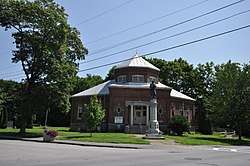Madison Public Library (Madison, Maine)
The Madison Public Library is located at 12 Old Point Avenue in Madison, Maine. Built with funding support from Andrew Carnegie, it is one of the architecturally most unusual libraries in the state, with a distinctive octagonal tower and non-rectangular angled elements. It was designed by the local firm of Snow and Humphreys and completed in 1906. The building was listed on the National Register of Historic Places in 1989.[1]
Madison Public Library | |
 | |
  | |
| Location | 12 Old Point Ave., Madison, Maine |
|---|---|
| Coordinates | 44°47′46″N 69°52′48″W |
| Area | 1 acre (0.40 ha) |
| Built | 1906 |
| Architect | Snow & Humphreys |
| Architectural style | Classical Revival |
| MPS | Maine Public Libraries MPS |
| NRHP reference No. | 88003022[1] |
| Added to NRHP | January 5, 1989 |
Architecture and history
The library is set at the southeast corner of Old Point Avenue and Pleasant Street, near the center of the main village of Madison. It is a single-story structure built of brick and stone, with Classical Revival features. The building is roughly triangular in shape, with two rectangular sections joined by an angled main facade that faces the street corner. The rectangular sections have standing-seam metal hip roofs, interrupted at the center by an octagonal tower, whose front-facing sections have diamond-pane windows, and which is encircled by a band of decorative brick corbelling.[2]
The front facade has a recessed entry section with stone columns and brick pilasters flanking, and a band of corbelled brickwork below a stone balustrade. The interior of the building is arranged with reading rooms and stacks in the rectangular side wings.[2]
The Madison Public Library was founded in 1886, and was housed in commercial spaces until this building was built in 1906, supported in part by an $8,000 grant from Andrew Carnegie. Designed by the local firm of Snow and Humphreys, its tower and angled wings are distinctive features not seen in other libraries throughout the state.[2]
See also
References
- "National Register Information System". National Register of Historic Places. National Park Service. July 9, 2010.
- "NRHP nomination for Madison Public Library". National Park Service. Retrieved 2015-04-06.